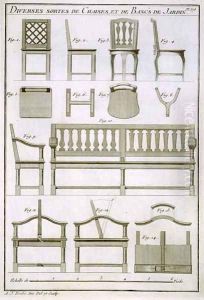Andre Jacob Roubo Paintings
André Jacob Roubo was born in 1739 in Paris, France, into an era where the craft of woodworking and the guilds that governed it were at their zenith. He was not just a woodworker but also an esteemed writer, engraver, and a visionary in the field of furniture making and carpentry. His contributions to the field were not limited to his craftsmanship but extended significantly into the realms of education and literature on woodworking.
Roubo's most notable work is 'L'Art du Menuisier' ('The Art of the Carpenter'), a comprehensive series of books published between 1769 and 1785. This magnum opus is a detailed account of woodworking techniques, tools, and the design and construction of furniture and buildings. It was an invaluable resource at the time and remains a critical reference for historians, craftsmen, and enthusiasts of woodworking and furniture design. The work is richly illustrated with plates that Roubo engraved himself, demonstrating not only his mastery of woodworking but also his skills in illustration and an understanding of the importance of detailed visual instructions.
Despite his significant contributions, Roubo's life was marked by financial struggles. The cost of publishing his extensive works, coupled with the limited audience they appealed to at the time, meant that Roubo did not gain significant financial rewards from his publications. He worked as a master carpenter and was a member of the Guild of Saint Thomas and Saint Luke, but the advent of the French Revolution brought about changes that affected craftsmen and guilds across France.
Roubo died in 1791, before he could witness the full impact of his works. However, his legacy endures through 'L'Art du Menuisier,' which continues to be a key resource in the study and practice of woodworking. His detailed observations and instructions provide insight not only into the craft of his time but also into the social and economic conditions that influenced the work of artisans in the 18th century. André Jacob Roubo is remembered not just as a master craftsman but as a scholar who elevated the status of woodworking to an art form and left an indelible mark on the field.
